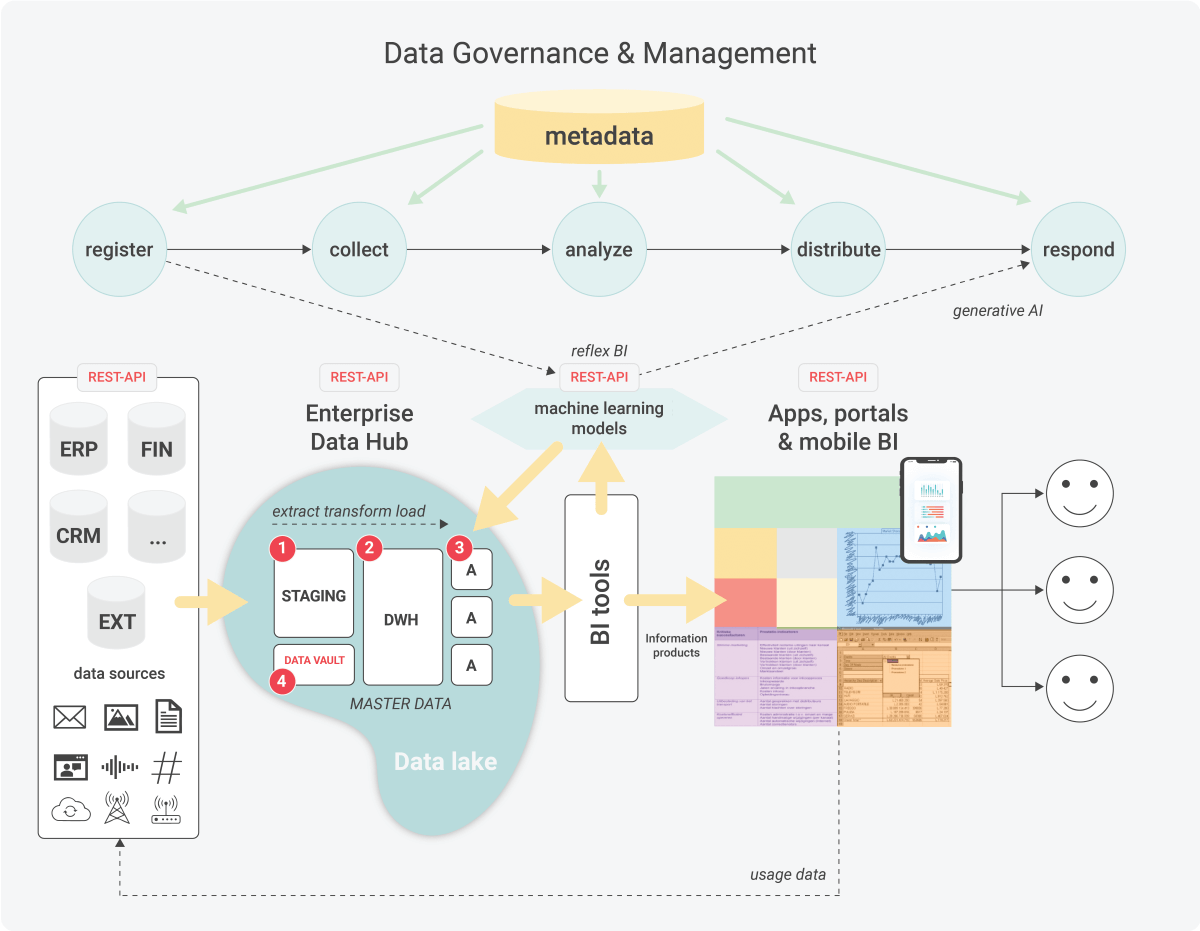Is a data warehouse essential?
As a manager, project manager, or BI consultant, you naturally want to develop a solid Business Intelligence architecture. You understand its advantages in terms of scalability, speed, data quality, and flexibility. However, you also hear stories of many data warehouse projects failing to deliver the desired results. Yet, there are also success stories, prompting you to investigate what distinguishes successful BI projects from failures. At Passionned, we believe that BI architecture should perfectly match the desired analyses, BI maturity, and data literacy of the employees. We aim to synchronize technology and people. If you want to learn more about implementing a successful BI architecture, we would love to help your company achieve that.
Relevant BI architecture issues
A solid Business Intelligence architecture provides many advantages when it comes to scalability, speed, data quality, and flexibility. But there are a lot of stories about data warehouse projects failing and not delivering the desired results. How should you approach this issue, and what are the relevant questions?
- Which architecture does an intelligent organization use, and how can you learn from that?
- BI architecture consists of layers. When and why do you need which components? What’s the added value?
- How to deal with Big Data and unstructured data. How do these different forms of data fit within your business intelligence architecture?
- How do the various Business Analytics tools and data integration tools fit within the architecture?
- Who should you involve when setting up BI architecture?
If you have one or more of these questions, Passionned Group’s BI consultants can help answer all your architecture-related questions and make forward progress towards becoming a more intelligent organization, from implementation to interim management.
The different components of BI architecture
A solid business intelligence architecture consists of different layers and components. These components should run in sync with the processes of the intelligent organization:
- Registering data in internal systems, databases, or with sensors.
- Collecting data, cleansing it, combining it, and aggregating it in a data warehouse or a data lake.
- Analyzing using Business Intelligence tools and analytical models.
- Distribution of insights, reports, dashboards, and analyses using portals and mobile BI.
- Reaction by the organization’s directors: the decision-making process.

Metadata supports and guides the overall BI process, so that the transition from one step in the process to the next takes place seamlessly.
“A” is the most important letter
The letter “A” in the word “architecture” is the most important one. It stands for acceptance by the users and stakeholders that have to work with it. These are the BI developers, BI consultants, data scientists, data analysts, and end users. The smileys on the right side of the diagram represent satisfied users. That’s what a Business Intelligence architecture should stand for. Unfortunately, in practice, it doesn’t always work out that way.
Structure follows function
Like a house containing different rooms that each have their own purpose, each component of BI architecture has its own purpose. When the goal is unclear or unknown, it’s pointless to design or build an architecture. This is one of the most common hurdles. That’s why it’s important to clarify which KPIs, insights, and analytical models you want to work with first, and which functions your BI tools should perform.
The business intelligence architecture and maturity
You shouldn’t put the cart before the horse, as they say. Unfortunately, this still happens on a large scale: many organizations set up a very mature and complex BI architecture, while the maturity of the business intelligence and its users is very low. This can only spell doom and financial disaster. Our experience tells us that a business intelligence architecture should be in lock-step with the maturity of an organization’s business intelligence, for the following reasons:
- You’re much more likely to be successful using business intelligence this way.
- No wasted money and considerably less risk.
- In case of success you have to consider revising your BI architecture every now and then.
Don’t buy into a data warehouse prematurely
Just because BI consultants and BI architects are convinced of the value of BI doesn’t mean that your users are too, or that they have the skills to extract value from data. So don’t get sold on a data warehouse or data vault prematurely. It’s self-evident that a mature BI organization like Albert Heijn, which was voted smartest organization in the Netherlands, needs a huge and mature data warehouse. They make a lot of money from it and it increases their customer satisfaction. If you pull the plug from their data warehouse, Albert Heijn would effectively drop down dead next week.
The advantages of a Business Intelligence architecture
✓ Cohesion between the various components for a better overview.
✓ High scalability in terms of data volume and user growth.
✓ Flexible reporting and analyzing, using BI to its full potential.
✓ Easier to manage thanks to its clear structure: satisfied users.
✓ Higher data quality and guaranteed response times.
Principles that dictate BI architecture
The goal of BI architecture isn’t just to divide everything clearly. Equally important is establishing principles that developers, data suppliers, and users should stick to. This is important in order to prevent discussions and differences of opinion about the exact design of the data warehouse or dashboard. If you notice these discussions in your own BI team, it may be time to sit down and hash it out.
The 7 basic principles of a proper Business Intelligence architecture
The basic principles relate to the following aspects:
 Symmetry: the architecture reflects the business processes. This principle helps in creating an overall picture of the business processes and a single source of truth. It also ensures that the Business Intelligence system seamlessly attunes to both the information needs and the challenges of the business operations.
Symmetry: the architecture reflects the business processes. This principle helps in creating an overall picture of the business processes and a single source of truth. It also ensures that the Business Intelligence system seamlessly attunes to both the information needs and the challenges of the business operations.- Granularity: data are submitted with as much detail as possible and displays the exact same granularity as the data in the source system(s). This principle increases the testability and verifiability of data and information in reports. It also allows for detailed reports because no information is lost. Information will be lost if concentrated rather than submitting detailed data (at a higher level).
- Synchronisation: the refresh rate of data in both the data warehouse and reports should coincide with the regularity and frequency of events in the relevant business processes. This prevents the organization from missing out on important events.
- Maintainability and scalability: the calculations, the intelligence, and the logic behind KPIs, measured values, and dimensions are preferably recorded in one and the same place – thus also on one single platform. This greatly improves maintainability and scalability.
- Hiding complexity for end users: end users should be able to directly select indicators and dimensions for use in reports or interactive analysis. This makes quick and easy reporting possible and it protects the organization from a situation in which each employee needs to (or can) assemble his own indicators.
- Flexibility: when we fill the Business Intelligence system, we usually include relevant surrounding and adjacent data from the source systems so that users can create as many meaningful combinations of indicators and dimensions as possible. This increases both the power and possibilities of the analysis function within the organization.
- Not depending on tools: an architect constructing a building needs to take into account which materials are available. Nonetheless, an architecture should, where possible, be separate (independent) from the tools used – or to be used (e.g. ETL and Business Intelligence tools).
Key contributors to a sustainable BI system
The above-mentioned basic principles may prevent the organization from compromising on aspects of Business Intelligence that have a major impact on the organization’s performance. The 7 basic principles are key contributors to a sustainable and lasting Business Intelligence system.
Get started on a solid business intelligence architecture
Our Business Intelligence architects and BI advisors are eager to help you. With their knowledge, experience, and awareness of the latest BI trends, they will help you build out a solid business intelligence architecture. Contact us for more information or an appointment.
About Passionned Group
 Passionned Group is a leading analyst and consultancy firm specializing in Business Analytics and Business Intelligence. Our passionate advisors assist many organizations, large and small, in selecting the best Business Analytics Software and applications. Every two years we organize the election of the Dutch BI & Data Science Award.
Passionned Group is a leading analyst and consultancy firm specializing in Business Analytics and Business Intelligence. Our passionate advisors assist many organizations, large and small, in selecting the best Business Analytics Software and applications. Every two years we organize the election of the Dutch BI & Data Science Award.

 Symmetry: the architecture reflects the business processes. This principle helps in creating an overall picture of the business processes and a single source of truth. It also ensures that the Business Intelligence system seamlessly attunes to both the information needs and the challenges of the business operations.
Symmetry: the architecture reflects the business processes. This principle helps in creating an overall picture of the business processes and a single source of truth. It also ensures that the Business Intelligence system seamlessly attunes to both the information needs and the challenges of the business operations.


